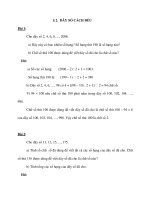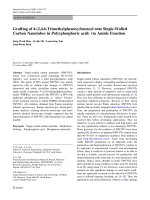Day 2 4 carbonate acid fracturing stimulations
Bạn đang xem bản rút gọn của tài liệu. Xem và tải ngay bản đầy đủ của tài liệu tại đây (39.23 MB, 85 trang )
slide 1
Geology ME
slide 2
! Enormous permeability contrast matrix - fracture system
! Short flush production of oil/gas
! Unwanted inflow of water through fracture system
! Large variation in reservoir types
Breakthroughs required É.
Reduction of water production
! Substantial
increase in production
reduction in well cost
slide 3
Well Type Conclusions
Vertical
Slanted
! Least Expensive
! Would require 85¡ penetration
! Straight-forward to frac
of reservoir for significant benefit
! Would exit area before reaching
base of reservoir
" Selected for Phase 1
# Not Suitable
Horizontal
Multi-Lateral
! Expensive to drill at this depth
! Complex & costly (at this depth)
! More difficult to frac
! Limited productivity improvement
due to low / no vertical permeability
! More difficult to frac
! Technology constantly developing
but not yet sufficiently mature
# Not Suitable
# Potential for Longer-Term
slide 4
! Enormous permeability contrast matrix - fracture system
! Short flush production of oil/gas
! Unwanted inflow of water through fracture system
! Large variation in reservoir types
Breakthroughs required É.
Reduction of water production
! Substantial
increase in production
reduction in well cost
slide 5
Chemical Fracture Shut‐off
NEED to KNOW……….
flow into the well bore
● How does water
● How do I stop it????
slide 7
Oil or Water ????
slide 8
Coiled tubing
Gelant in sea water
Water flooded Zone
Oil bearing Zone
Re-perforation target
Calcium Chloride/Bromide Fill
slide 9
IN-DEPTH FLOW DIVERSION
Injector
Producer
Low k
zone
High k zone
Low k zone
1. Water injection flushing mainly the high k zone
2. Injection of system to block flow through high k layer
3. Injected water diverted to low k layers resulting in improved oil production
slide 10
SELF-SELECTIVE SYSTEMS MICRO SCALE
Oil Path
water Path
Polymer
Oil
Oil
@ Srw
Water
Polymer
@ Sor
Polymer Injected
Polymer Injected
Oil/gas flows through the middle
of the pore channel. Slight effect by
adsorbed polymer on oil/gas flow
Water flows mainly along the sand.
Water mobility reduced because
water flow path partly occupied
by adsorbed polymer.
New technology to Stop Inflow of Water
¥ Controlled chemical release
Ð Intelligent gels
Ð Controlled fracture shut-off
Ð Super absorbents
Ð Self-Selective shut-off
water diffusion
Slow nutrient
release
slide 12
Current Applications
☛ Carbonless copy paper
☛ Pharmaceutical chemicals
➢ slow release enables drugs to be administered less
frequently and impart some target selectivity
☛ Agrochemicals
➢ controlled release of chemicals i.e.. the insecticides
PenncapM (methylparathion) and KNOX OUT
2FM (diazinon)
☛ Cosmetics
➢ liposomes which allow skin penetration but prevent
adsorption into the blood stream.
➢ Clearasil
! Enormous permeability contrast matrix - fracture system
! Short flush production of oil/gas
! Unwanted inflow of water through fracture system
! Large variation in reservoir types
Breakthroughs required É.
Reduction of water production
! Substantial
increase in production
reduction in well cost
Or in Low permeability
Carbonates
Hydraulic (acid)
slide 15
Carbonates
! Limestone
! Chalk
! Dolomite
Calcium
or
Calcium/magnesium
Carbonate
slide 16
Dissolves in:
slide 17
Types of Acid
! Plain HCL + viscous Pad
! Gelled HCl
! Chemically retarded HCL
! Emulsified acid
! Self diverting acid
slide 18
ReacΚon‐Rate Modeling
2HCL + CaCO3
CaCl2 + CO2 + H2O
4HCL + CaMg(CO3)2
CaCl2 + 2CO2 + 2H2O + MgCl2
Reaction rate:
m
rHCl = kjA CHCl
m= reaction order
CHCl= concentration
kj= reaction rate constant
A= surface area
kj= k0 exp ( -Ea/RT)
Ea= activation Energy
R= Arrhenius constant (8.3)
slide 19
Exercise
! Limestone:
! 1 gram of pure HCl dissolves 1.372 gram of rock
! Dissolving Power Xc is volume of rock
dissolved by volume unit of acid
ρcC 1.372
Xc =
ρCaCO3
Calcite:
ρ28% = 1.14 $ X28= 0.161
ρ15% = 1.07 $ X15= 0.082
Dolomite:
ρ28% = 1.14 $ X28= 0.141
ρ15% = 1.07 $ X15= 0.071
slide 20
Exercise
! For an acid etched fracture of 50 m long by
30 m high and 4 mm wide in Limestone
! How much (m3) 28% acid do I need
! How much 15% acid do I need
slide 21
Exercise
! For an acid etched fracture of 50 m long by
30 m high and 4 mm wide in Limestone
! How much (m3) 28% acid do I need
! How much 15% acid do I need
Rock volume to dissolve:
2x 50x30x0.004= 12 m3
X28= 0.161 m3/m3
75 m3 28% HCL
slide 22
ReacΚon Rate Modeling
! Acid transport to and reaction at the rock
! Acid depletes towards the fracture tip
! Heat transfer, as reaction is temperature
sensitive
! Leak‐off of acid into formation (reactive!)
slide 23
Temperature profile
hot
cool
Wall layer
slide 24
Temperature profile in Limestone frac
20 min
10 min
30 min
Blue is aer cease pumping
Source: spe26185
slide 25


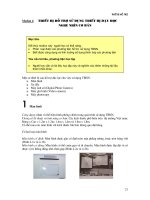

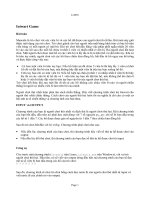
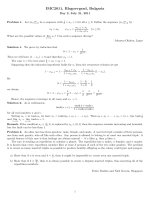
![TỔNG HỢP MỘT SỐ N-ARYL/HETARYL 2-{4-AMINO-5-[(4,6-DIMETHYL PYRYMIDIN-2-YLTHIO)METHYL]-4H-1,2,4-TRIAZOL-3-YLTHIO}ACETAMIDE](https://media.store123doc.com/images/document/14/y/vn/medium_Yr8VohbjEU.jpg)

